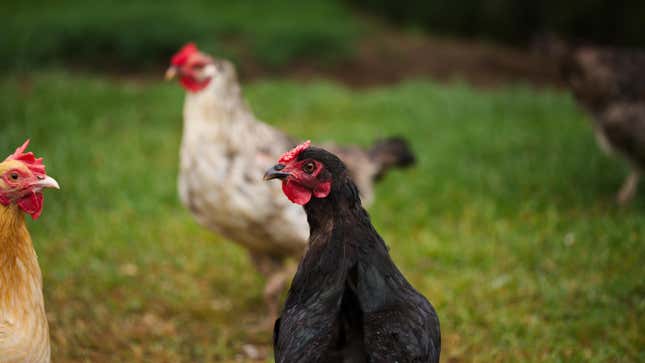
I love an heirloom tomato; Black Krim and Aunt Ruby’s are some of my favorites to grow in the garden. I’m a huge apple nerd as well, and I love antique varieties like Roxbury Russet and the Zabergau Reinette. I’ll admit I’ve never tried heritage breeds of chicken (although I roasted an actual wild turkey once), so when my husband came home from the grocery store with an heirloom bird, I was intrigued.
Heritage breeds of roasting chickens are reportedly more flavorful than typical grocery-store fowl, with the tradeoffs of having less breast meat and being way more expensive. But the chicken my husband brought home looked and tasted more or less like a normal grocery store chicken—and it was $3.19 a pound. That’s maybe on the higher end for a grocery store, but nowhere near what I’d expect for heritage breed prices.
I spent some time researching the brands and the words on the label before I had my “aha” moment—this was sold as an heirloom chicken, not a heritage chicken. Wait, what?
“Heirloom” is for vegetables
I first learned about heirloom tomatoes in the early aughts, in the context of sustainable food and organic gardening. These are varieties like the lumpy Brandywine, their seeds passed down through generations, unlike the modern hybrids you’re more likely to find at the grocery store.
Heirlooms have a lot going for them. They’re often varieties grown to have a specific feature or serve a particular purpose. Extra juicy, perhaps, or they may have an unusual flavor or color. The reason they fell by the wayside is often because they didn’t have what it takes to survive in the world of commercial mega-farming—the juiciest tomatoes lost out to the tomatoes that were less likely to bruise in their shipping crates.
But if they don’t work on a factory farm, heirloom tomatoes are still great for home gardeners. You can enjoy tomatoes (or beans, or carrots) that wouldn’t work in an industrial-scale operation because you aren’t running an industrial-scale operation. Notably, heirloom varieties of many plants can be propagated without setting up a separate breeding program. “open-pollinated” is the term you’ll see on labels; it means you can save the seeds, plant them again next year, and get the same kind of tomato.
The opposite approach would be “hybrid” tomatoes, which are fresh (F1) crossbreeds of two different varieties. If you harvest an Early Girl tomato, its seeds will not make more Early Girls. You’d have to start from scratch and cross the parent strains again. Seed companies do this; home gardeners don’t bother.
Want to plant some heirloom seeds in your garden? Try these unusual-looking late season veggies:
- Royal burgundy beans (green beans that are purple when raw)
- Dragon’s tongue beans (pink and white streaked when raw)
- Golden Detroit beets (yellow)
- Black nebula carrots (black)
- Round parisian carrots (spherical like radishes)
- French breakfast radishes (elongated like baby carrots)
Meanwhile, in the world of apples, varieties that have been passed down over the generations are known as “antique” rather than heirloom. I once heard an apple expert describe “heirloom” as a general term for varieties that we suspect are old, and “antique” for those whose history is well-documented; I’m not sure if that distinction is commonly used or was just their personal way of thinking of it. (Fun fact: apples never grow true from seed, so they are propagated by grafting a branch of the tree you want onto another tree’s roots. “Open-pollinated apples” are not a thing.)
“Heritage” is for livestock
Let’s return to the chickens. Old breeds of chickens, pigs, cattle, and other livestock are called “heritage” breeds. The Livestock Conservancy defines heritage chicken breeds according to whether they were recognized by the American Poultry Association prior to the “mid-20th century.” You can browse a full list of the livestock breeds that the Livestock Conservancy recognizes, including notes on which ones are in most danger of disappearing.
As with heirloom tomatoes, heritage breeds of chickens (and other livestock) are ones that were popular in the past, but are not common in modern, large-scale farming. In the 1940s and 1950s, chicken breeders held a nationwide competition to produce the plumpest, fastest-growing chickens. Hybrids of the winners, and birds like them, now dominate grocery store aisles. These days you may have to visit a specialty farm if you want one of the old-fashioned breeds.
There’s a reason you haven’t heard of “heirloom” chickens
So how did a “heirloom” chicken end up in my grocery store? Before I noticed the subtle shift in terminology, I wrote to the company to ask “which heirloom breed” their chickens were. A spokesperson wrote back to say that the company had worked for a decade to create a new breed from heritage-breed parents, including the Transylvanian Naked Neck and the Delaware. They call their breed the Pioneer. So it’s not an old breed at all, but a new one. That’s why they can’t call it “heritage”—but nobody is stopping them from using the term “heirloom,” though “heirloom chicken” isn’t a commonly understood phrase. (It does sound a lot like one though.)
The ultimate result of the chicken breeding is that the company used heritage birds’ genetics to breed a bird they say is healthier and takes better to outdoor conditions than typical factory-farmed birds. (And the bird we bought was pasture raised and Certified Humane, which are both good signs.) I can’t be too mad about that—but I still think the vocabulary swap was misleading.
